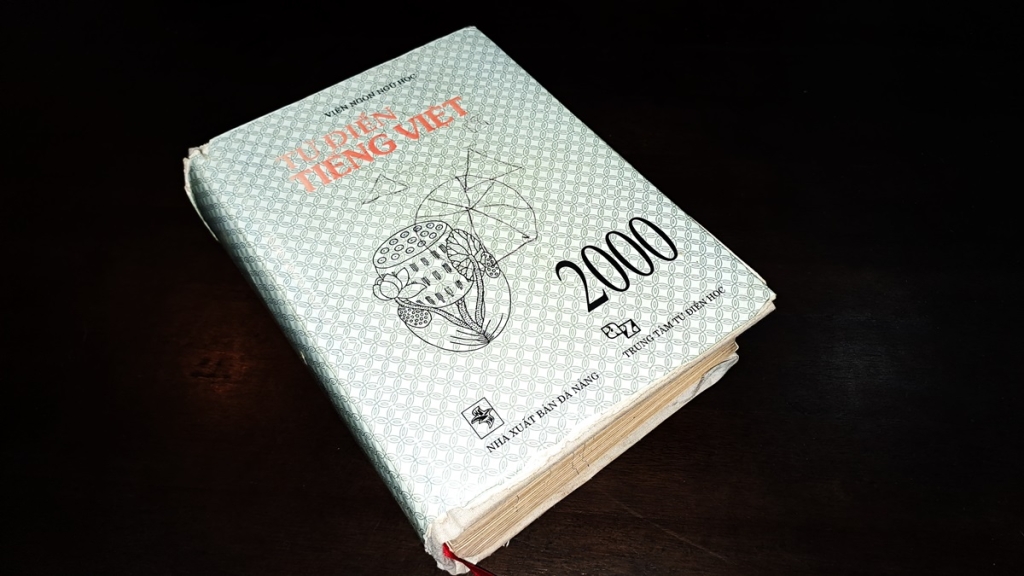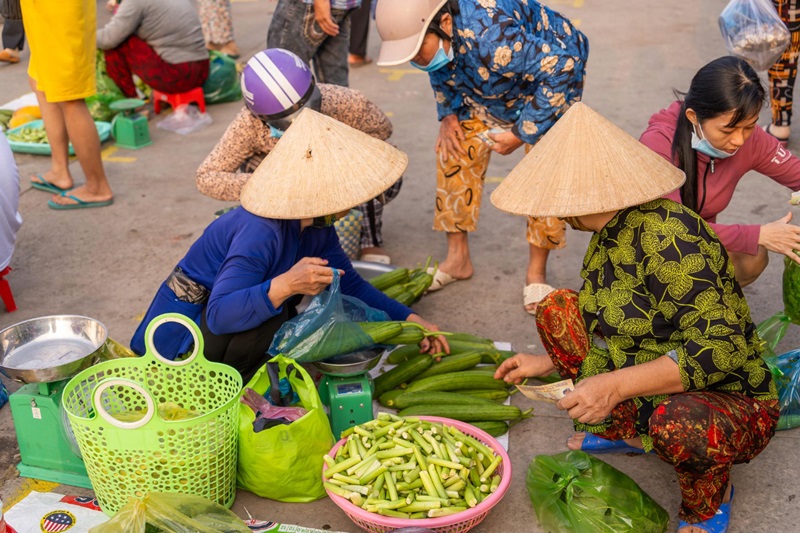Vietnamese is the official language of the Vietnamese people. Up to now, no additional language has been regulated by the government of Vietnam as the second national language.
Contents:
- Ninety languages used as mother tongues in Vietnam
- History of the Vietnamese Language
2.1. About spoken language
2.2. Regarding the origin of Vietnamese writing - Vietnamese listed as the top 20th language in the world
- Outstanding features of the Vietnamese language
4.1. Vietnamese does not have “Tense”.
4.2. Words do not change form.
4.3. Vietnamese does not distinguish between “Gender”.
4.4. The meaning of words changes when the tone changes. - Vowel and consonant system in Vietnamese
- Vietnamese dialect regions
- Some basic Vietnamese communication sentences for tourists
7.1. Common words and sentences
7.2. Cardinal number
7.3. A few sentences in emergencies

1. Ninety languages used as mother tongues in Vietnam
A total of 54 ethnic groups live scatteredly throughout the S-shaped land of Vietnam. The ethnic diversity has led to language diversity.
According to researchers’ statistics, across the country, there are currently more than 90 various languages used by ethnic groups as their mother tongue. Among them, the Kinh group (also called Viet Group), who speak Vietnamese as their mother tongue, accounts for more than 85% of the population. Because of this dominance, Vietnamese has become the official language of the whole country.
However, the Vietnamese government still has policies to maintain and improve the unique voices of ethnic minorities. For example, in addition to Vietnamese, in some ethnic minority areas, the languages of the local minority groups have been used as the subject or medium of teaching in general education programs.
The Voice of Vietnam, Vietnam Television, or the local radios and televisions also have broadcasts in ethnic minority languages, such as Khmer, Ede, Ba Na, Mong, Gia Rai, Co Tu, and Xe Dang.
When traveling to different regions in Vietnam, you have a good chance to study linguistic diversity. For example, Khmer in the Mekong Delta; Ede language in Dak Lak and Gia Lai Provinces; and H’Mong spoken in the northern mountainous provinces, including Ha Giang, Lang Son, Lao Cai, and Dien Bien Provinces.
2. History of the Vietnamese Language
A language usually includes two parts: spoken and written. In particular, the voice part always comes first. Writing is characters that are used to record speech. A language may not have writing, but it must have a saying.
The history of Vietnamese will include the birth of spoken and written language.
2.1. About spoken language:
Until now, many researchers have accepted different hypotheses about the origin of Vietnamese.
a. The first hypothesis is that Vietnamese is just a degenerate branch of Chinese. The representative of this hypothesis is Jean-Louis Taberd (18th June 1794 – 31st July 1840, French). The basis of this hypothesis is that the Vietnamese vocabulary contains plenty of words originating from Chinese.
b. Another hypothesis is that Vietnamese originates from the Austronesian language family. Representing this viewpoint is Binh Nguyen Loc (7th March 1914 – 7th March 1987) with outstanding research works: “The Malay Origin of the Vietnamese People”, and “Unmasking the Vietnamese Language”.
c. The third hypothesis appeared at the beginning of the twentieth century when Henri Paul Gaston Maspero (15th December 1883 – 17th March 1945, French) put forward many convincing arguments that Vietnamese originated from the Thai language family. For a long time, it was accepted that Henri’s hypothesis was well-founded.
d. The fourth hypothesis showed plenty of scientific evidence that the Vietnamese language originated from the Viet-Muong group of the Mon-Khmer branch of the Austroasiatic family. Representing this hypothesis is André Georges Haudricourt (17th Jan 1911 – 20th Aug 1996, French).
Currently, lots of scientists agree with the viewpoint of the fourth hypothesis because of the rigorous, well-founded, and convincing argument system. We also agree with this point of view.
2.2. Regarding the origin of Vietnamese writing:
Throughout history, Vietnamese writing has had a lot of changes, starting from Hán (Chinese) to Nôm and today to Quốc Ngữ (the national language written following Latin).
a. Hán (Chinese) characters: is the longest-lasting writing system in the history of Vietnamese.
It started with the fact that ancient Vietnamese people used Chinese hieroglyphs to record and communicate in trading. With the development of society, Chinese characters became the official script used by Vietnam’s historical feudal regimes for teaching, taking exams, promulgating regulations, drafting and storing documents.
The Vietnamese people used this Chinese writing system until the 18th century.
b. Nom script: around the 10th century, Nom script began to take shape.
This writing is also a hieroglyphic system built based on Chinese characters. For that reason, there are many similarities between Chinese and Nom characters. However, these are still two different writing systems, and Nom has a separate writing system created by the talents in Vietnam.
Around the 14th and 15th centuries, the Nom script began to be perfected and went into a brilliant development process from the 17th to 19th centuries.
c. The National language (Quốc Ngữ):
By the 16th century, the National language began to be conceived. Initially, these were just Latin characters used by Western missionaries to transcribe the names of places, people, and religious titles in Vietnamese.
Gradually, more and more documents recorded Vietnamese phonetic transcriptions in Latin letters and formed the An Nam script. The process of development and improvement took place continuously; until the 19th century, Vietnamese writing had its complete structure system.
By 1945, the Quoc Ngu script following the Latin alphabet completely replaced the hieroglyphs of Nom and Chinese. It became the official and unified writing of Vietnam. This writing is constantly improving and developing today.
3. Vietnamese listed as the top 20th language in the world:
According to statistics, about 85.3 million people speak Vietnamese globally, and it is the 20th language in the world in terms of the number of speakers.
Vietnamese is not only used in Vietnam but also in many other countries. It appears in Vietnamese communities abroad, such as the US, Canada, Australia, England, Germany, the Netherlands, Finland, France, New Zealand, Thailand, Singapore, China, and Japan.
4. Outstanding features of the Vietnamese language
Vietnamese belongs to the type of isolating language, so it has typical characteristics as the following:
- Words do not change morphology;
- Function words and word order play the role of clarifying grammatical relationships and grammatical meanings of words and sentences;
- The relationship between words is independent, free, and not bound to each other;
- Each word in Vietnamese is a syllable and also a morpheme.
From these general things, we can recognize the specific features of Vietnamese as below:
4.1. Vietnamese does not have “Tense”.
In English, “Tense” plays an important role in determining the structure and meaning of a sentence, but “Tense” does not exist in Vietnamese.
Function words and word order in the Vietnamese language take on the role of clarifying the grammatical relationship and meaning of the sentence.
For example, when you want to describe something happening in the future, the sentence can have function words, such as sẽ (will), chuẩn bị (be going to), sắp sửa (be about to, nearly happen), gần (recently).
The speakers can also use adverbs of time, such as Ngày mai (tomorrow), Ngày kia (the day after tomorrow), Một lát nữa (a moment later), Chiều nay (this afternoon), Chiều mai (tomorrow afternoon). The speakers do not need to use “Tense” in sentences.
4.2. Words do not change form, and word order determines the meaning of a sentence.
In Vietnamese, each word has an independent meaning, and there is no situation of morphological change. Elements such as prefixes and affixes do not appear in Vietnamese. Instead of that, word order determines the meaning of the sentence.
For example, when changing the order of words in this sentence:
“Tôi(1) hát(2) không(3) hay(4)”- “I don’t sing well”
Then, the meaning of the sentence will change:
“Tôi(1) không(3) hay(4) hát(2)” – “I don’t sing often”;
“Hay(4) tôi(1) không(3) hát(2)?” – “Cannot I sing?”;
“Tôi(1) hát(2) hay(4) không(3)?- “Do I sing or not/ Do I sing well?”
4.3. Vietnamese does not distinguish between “Gender”.
There is no distinction between “feminine” or “masculine” like French. This feature makes identifying and learning nouns in Vietnamese much easier.
4.4. The meaning of words changes when the tone changes.
One of the special features of Vietnamese is the tonal system that represents the pitch of the voice. They are expressed by signs: ngang (no signs), sắc (sharp), huyền (slidedown), hỏi (question), ngã (laying), and nặng (drop).
That means that when the pitch of a word changes, the tone changes, which creates different meanings of words.
For example, changing the tone of the word: “Me – Tamarin” will create words with completely different meanings, such as:
- Mè – Sesame
- Mé – One side
- Mẻ – Fermented rice or vermicelli has a sour taste
- Mẽ – A person’s appearance implies irony
- Mẹ – Mother
5. Vowel and consonant system in Vietnamese
Vietnamese has:
- 12 simple vowels: a, ă, â, e, ê, o, oh, ê, i, u, u, y.
- 31 diphthongs: ai, ao, au, ay, âu, ây, eo, êu, ua, uă, uâ, uê, uô, uơ, ui, uy, ưa, ưi, ưu, ươ, ia, iê, iu, oa, oă, oe, oo, oi, ôi, ơi, yê
- 14 three vowel sounds: oai, oao, oay, oeo, uay, uây, uôi, uya, uyê, uyu, ươi, ươu, iêu, yêu
- 17 simple consonants: b, c, d, đ, g, h, k, l, m, n, p, q, r, s, t, v, x
- 11 compound consonants: ch, gh, gi, kh, ng, ngh, nh, ph, qu, th, tr
6. Vietnamese dialect regions
Many opinions agree on dividing Vietnamese into three basic dialect regions: North, Central, and South.
However, in reality, there are more specific Vietnamese dialects. For example, a group of the Middle dialect can cover various dialect areas with different characteristics, such as the Hue dialect, Quang Nam dialect, and Binh Dinh dialect.
The big difference between dialect regions creates a lot of difficulties for people learning Vietnamese for the first time. Ex, speakers familiar with the Northern dialect will have a few obstacles in understanding the pronunciation of Hue or Hoi An – Quang Nam people and vice versa.
Listening to and understanding Vietnamese dialects is even more challenging for international tourists.
But, sometimes, that dialect difference will bring you plenty of exciting experiences. For example, when using the word “Cảm ơn” (Thank you) in different regions, you will hear various ways of saying it, such as:
- Phu Yen people: “Kẻm ơn” – the vowel “a” in the word “Cảm” (thanks) is said incorrectly as “e”.
- Hoi An people will say “Cổm ơn” – the vowel “a” in the word “Cảm” (thanks) is changed to the “ô” sound.
- Hue people say: “Cạm ơn” – the “hỏi”(question) tone in the word “Cảm” (thanks) is transformed into the “nặng” (drop) tone.
7. Some basic Vietnamese communication sentences for tourists:
Lots of Vietnamese people can communicate in English at tourist destinations, so no worries, you can travel to Vietnam when you know only English.
However, when you can use a few basic Vietnamese sentences and words, you can make the conversation more interesting.
7.1. You may learn some common words and sentences as below:
Xin chào – / Xin chào/ (Hello)
Tạm biệt – /tarm byet/ (Goodbye)
Cảm ơn – /kam uhn/ (Thank you)
Bạn khỏe không- /ban kwe khom/ (How are you?)
Rất vui được gặp bạn – /rack vu duoc gef ban/ (Nice to meet you)
Bạn tên gì? – /ban ten zi/ (What is your name?)
Tôi tên là – /toy ten la/ (My name is)
Bạn nói tiếng Anh được không – / ban noi tien an duoc khom/ (Can you speak English?)
Chúc bạn vui vẻ – /chuok ban vui ve/ (Happy to you)
Món ăn này rất ngon – /mon ank nay rak ngon/ (This food is delicious)
Bao nhiêu tiền? – / bao niew tien/ (How much?)
Tôi muốn mua cái này – /toy mun mua kai ney/ (I want to buy this)
Có bớt không? – / co baed khom/ (Discount, please?)
7.2. Cardinal number:
Một – 1 – /mort/
Hai – 2 – /hi/
Ba – 3 – /ba/
Bốn – 4 – /bone/
Năm – 5 -/nom/
Sáu – 6 -/shoz/
Bảy – 7 – /by/
Tám – 8 – /tum/
Chín – 9 – /chin/
Mười – 10 – /muoi/
7.3. A few sentences in emergencies:
Giúp tôi với – /giup toy voi/ (Help me, please!)
Giúp tôi gọi cấp cứu – /giup toy goi kap kuw/ (Help me call an ambulance)
Tôi cần đi bệnh viện – /toy kan di benk vien/ (I need to go to the hospital)
Tôi muốn gặp bác sĩ – /toy mun gap bac si/ (I want to see a doctor)
Chỉ giúp tôi quầy bán thuốc – /Chi giup toy quey ban thuk/ (Please show me a pharmacy!)
Giúp tôi gọi cảnh sát – /giup toy goi kank sack/ (Help me call the police!)
Cứu tôi với – /kuw toy voi/ (Help me!)
Tôi bị đau – /toy bi down/ (I’m in pain)
If you want to discover more about Vietnamese, travel to Vietnam now. Vietnamdrive is here and available to support you in planning a perfect trip in this beautiful country.
Linguistics Master Vu Xuan Thinh wrote this article under the order of Vietnamdrive. We have all rights to translate and use it.


